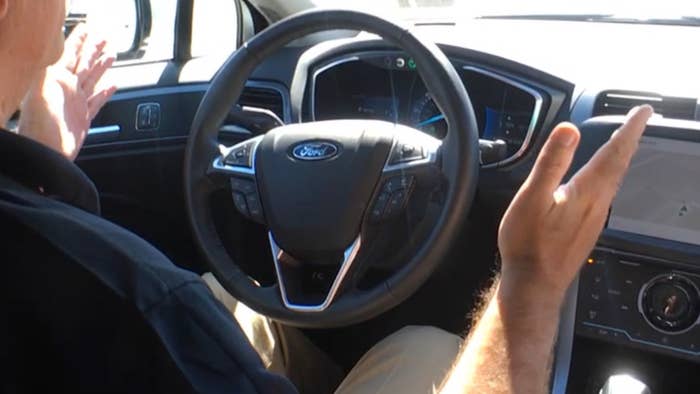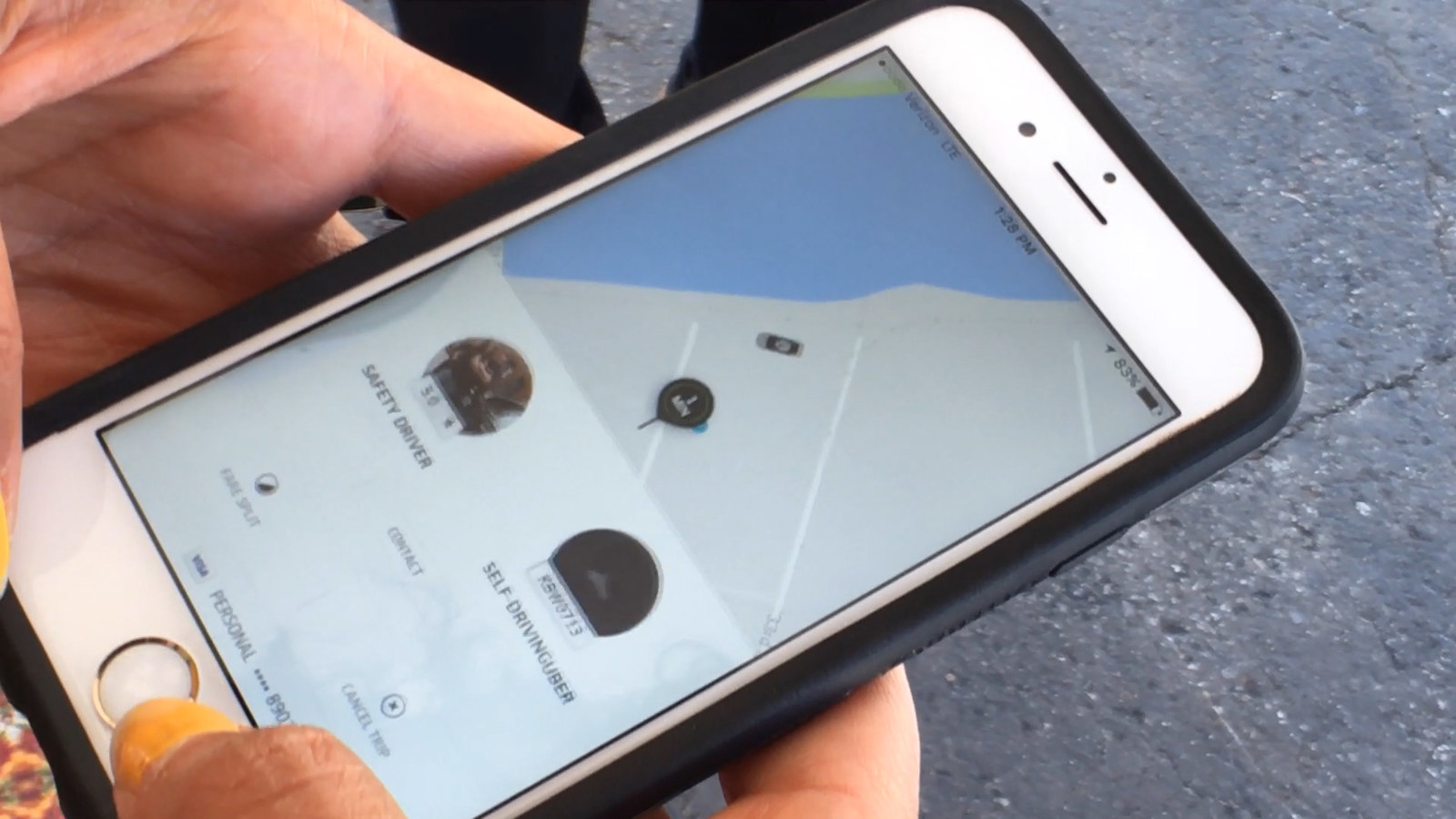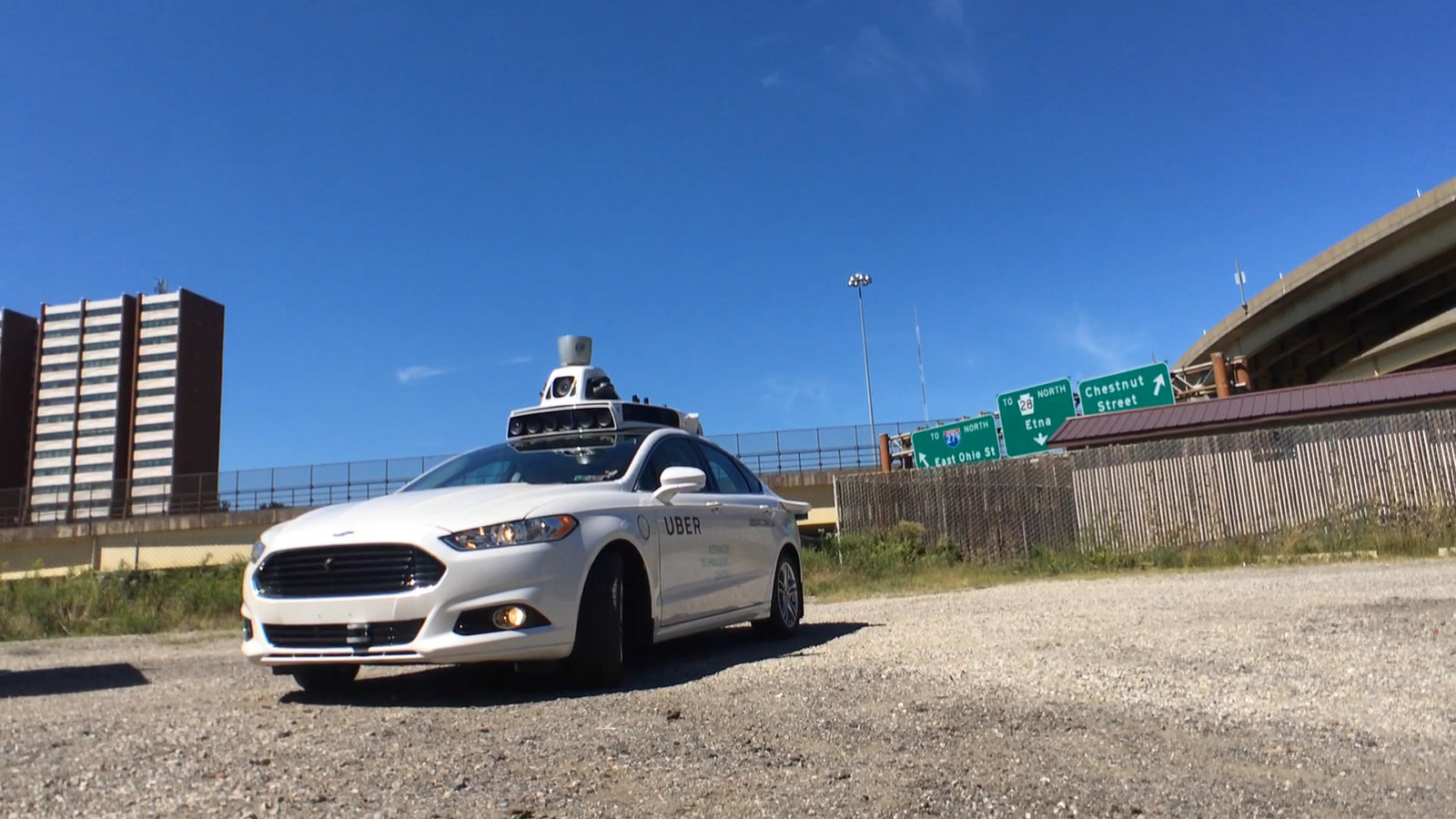Pittsburgh, Pennsylvania — once a titan of the steel industry — has a new claim to fame: first city in the United States to let passengers hail rides in self-driving cars.
Beginning Wednesday morning, Uber customers in the former steel town who've agreed to participate in the company's self-driving car pilot program will have a reasonable chance of being picked up in an autonomous vehicle — albeit one carrying both a safety driver (ready to take the wheel during emergencies) and a co-pilot (to monitor the car and its route on a laptop).
Uber's Pittsburgh pilot program is kicking off with just a handful of self-driving Ford Fusions, but will later expand to include an additional 100 self-driving Volvos. For now, the cars aren't entirely autonomous. A human driver brings the car to the road before hitting the silver button that activates autonomous mode. This safety driver sticks around for the duration of the ride, ready to intervene should something go awry on the journey. Also aboard is a co-pilot in the front passenger seat, watching for glitches and anomalies and sending notes to Uber’s developers, who are refining the algorithms the cars use to navigate.
When automated elevators were first introduced in the 1950s and human operators were no longer needed to man them, the transition was so jarring that some elevator manufacturers added voice narration to reassure people — "Please press the button for the desired floor." For Uber's driverless car pilot, backup drivers and co-pilots will likely serve a similar purpose — a reassuring presence for people coming to terms with something new and unfamiliar.
Cameras will record the rides of passengers who agree to be part of the pilot program, and Uber says that footage will help improve the experience over time. Riders will receive phone calls asking for feedback on their trips: What did they like? Did anything make them nervous? Were they at all uncomfortable?
“If you think about it, every month, Uber drives over a billion miles," Anthony Levandowski, who leads Uber’s self-driving efforts, explained. "That data gives us insight into how a city works, where are people driving, where are they getting into accidents, how pickups and drop-offs work." Levandowski should know. He worked on Google’s self-driving car team before co-founding the self-driving truck startup Otto, which Uber acquired this summer.

As fascinated as we might be by the idea of self-driving vehicles, the thought of actually riding in one is sometimes cause for trepidation. Indeed, 3 out of 4 US drivers said they feel “afraid” to ride in a self-driving car, according to an AAA survey of 1,832 US drivers ages 18 and older in January. Only 1 in 5 said they would trust an autonomous vehicle enough to ride in one. That’s more anxiety than the Pew Research Center noted in a 2014 survey, which found that 48% of people would be interested in riding in a driverless car if given the opportunity.
Perhaps with this in mind, Uber has docked an iPad in the back of every Ford Fusion as a sort of informational distraction. It displays the car’s route and also gives riders a sense of what the car itself “sees” — multicolored outlines of other vehicles on the road, and whatever else its sensors are picking up at the time.

But why Pittsburgh?
“Pittsburgh is an ideal environment for us,” Raffi Krikorian, director of Uber’s Advanced Technologies Center, told BuzzFeed News. “Pittsburgh is an old city. It has organic road networks. It has a real traffic problem. It experiences extreme weather. We really feel that if we can master driving in Pittsburgh, we can easily master driving in other cities around the world.”
"If we can master driving in Pittsburgh, we can easily master driving in other cities around the world."
But there are other reasons as well. Pittsburgh is home to Uber’s Advanced Technologies Center, which opened about 18 months ago. The company ravaged nearby Carnegie Mellon University’s robotics unit, poaching about 40 researchers to work on its own driverless car program. And Pittsburgh is an Uber-friendly city. As the city’s mayor, Bill Peduto, recently told the New York Times, “It’s not our role to throw up regulations or limit companies like Uber.”
While Uber is free to send its autonomous cars anywhere in the city, the company will focus on the most popular routes and areas, and ones that mirror traffic patterns in other cities.

Bryant Walker Smith, chair of the Planning Task Force for the On-Road Automated Vehicle Standards Committee of the Society of Automotive and Aerospace Engineers, told BuzzFeed News that Uber's self-driving car pilot program in Pittsburgh will give people a more realistic view of the potential and limitations of automated driving.
“The public will play an important role in shaping both social and legal expectations for these vehicles,” Walker Smith said. “That's why companies like Uber should publicly share their safety philosophies — how they define, measure, document, and monitor the reasonable safety of their vehicles now and into the future.”
Self-driving cars have long been expected to upend the transportation industry, and there are a number of companies racing to deliver viable autonomous vehicle solutions. Google has been testing its self-driving cars on the road for years. Ford claims it will mass produce self-driving cars by 2021. Meanwhile, US Department of Transportation Secretary Anthony Foxx is saying we’ll all be riding in self-driving cars within five years — and his agency is the one writing the rules that will govern them. But Uber’s Pittsburgh pilot marks the first larger effort to put people — real people, outside of technologists and media — in self-driving cars in real-world circumstances. And that's a big deal.
